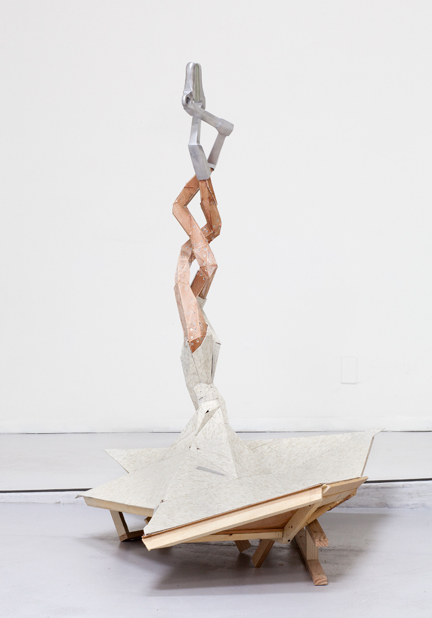At the core of Rebecca Ripple’s practice is the question of historical authority and traditional truths—who sets the stage for what truth means and how it gets enforced. In past works, she has examined the bounds of Catholicism, the issue of constraining the female body and how the dictates of ideological or political systems are transmitted. She continues these investigations in “licking yellow fog,” an exhibition of sculpture and drawings. Here she also delves into how domesticity—specifically suburban rule systems—and individual perception entwine.
Typical of Rebecca Ripple’s artwork, Scorpion (2012) explores the contradictions at the heart of a life under scrutiny and interrogation. A makeshift set of wooden struts supports a jagged, fragmentary group of linoleum tiles erupting upwards. From the center of this improvised floor, two interwoven tendril-like elements emerge, at first carefully covered in the kitchen linoleum and then progressively encased by faux wood material. Two cast aluminum elements crown the work. Located somewhere between a set of blunted scissors/forceps or an enlarged speculum, the open hinge looks like alternately threatening blades or the hand signal for A-okay.
Rebecca Ripple’s sculptures typically combine both found and fabricated sources, making use of heavily worked materials, through which she continues in her exploration of the contradictory intersections between art and the everyday. In particular, her 3D work evokes a simultaneously visceral physical response together with a protracted intellectual quandary, pulling the viewer into her musings.
Paradox is often a strategy Ripple deploys in her search for the schisms she sees between the religious and the secular, the generalized and the idiosyncratic, the reasoned and the emotive. In a work such as belt (2012) the leather fragment of a belt, looking much like a wizened black tongue, is affixed via transparent tape to a linoleum tile set off the wall by a clear acrylic box. Is the fetish meant to conjure up the act of licking the kitchen floor clean, being tongue-tied, or is it simply two unlikely fragments of domesticity which collide in an abject assemblage celebrating brute materiality covered with the signs of a past life? The strength of Ripple’s work resides on being able to straddle those multiple interpretative axes without losing pungency and significance, whichever axis any given viewer favors.
Her drawings give insight into the poetic construction she is creating. Notes to herself about how many haloes of meaning to incorporate into a given sculpture bear witness to the complexity of inferences she is building up. The scrawled images themselves favor the conditional and variable: conditions that are a part of her working process. A passionate fixity to her desires is tempered by a provisional quality to her results, underscoring the anxiety of her interrogatives.
Like the title of the exhibition, which refers to the yellow fog of T.S. Eliot’s The Love Song of J. Alfred Prufrock, with its difficult stanza, Ripple’s sense of the inscrutable is that it is something to be seen and felt, rolled over in the imagination, but not ever entirely consigned to the bounds of language.


